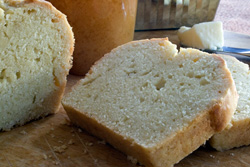 Where I live, it is very, very cold. There are icicles on the trees, cars must be started at least 10 minutes before one actually wishes to make the first foray of the day, and everyone has boots with tread, a shovel, and backup pair of gloves. This morning, sidewalks and streets were covered with a sheet of ice, and we semi-seriously contemplated getting to church by sliding down the hill from our house. (Not that my life is all that Norma Rockwell-ian, but we actually do live at the top of a hill, and our church is more or less at the foot of said hill).
Where I live, it is very, very cold. There are icicles on the trees, cars must be started at least 10 minutes before one actually wishes to make the first foray of the day, and everyone has boots with tread, a shovel, and backup pair of gloves. This morning, sidewalks and streets were covered with a sheet of ice, and we semi-seriously contemplated getting to church by sliding down the hill from our house. (Not that my life is all that Norma Rockwell-ian, but we actually do live at the top of a hill, and our church is more or less at the foot of said hill).
On a Sunday night when it’s been gray and cold forever, and the promise of the holidays is gone along with the first, unsullied snow, dinner needs to provide more than fuel. Demoralized persons (particularly those returning to school tomorrow after a blissful vacation) require something to lift the spirits in a way that cannot be accomplished with meatloaf or macaroni. Saving the demoralized requires something a little more interesting, a little more labor-intensive, and definitely farther outside the box.

 It feels like Week 19 of the heat wave. Seriously, ridiculous. It’s too hot to stay in and cook. Baking seems ludicrous. Even making a pot of chili in the afternoon (to serve later with grilled hot dogs or hamburgers) feels like too much – which reminded me of the Cuisinart. It sits on the counter every day and we rarely use it. Why did I forget about the Cuisinart?
It feels like Week 19 of the heat wave. Seriously, ridiculous. It’s too hot to stay in and cook. Baking seems ludicrous. Even making a pot of chili in the afternoon (to serve later with grilled hot dogs or hamburgers) feels like too much – which reminded me of the Cuisinart. It sits on the counter every day and we rarely use it. Why did I forget about the Cuisinart? Recently my friend Alice, who is a very fine cook, e-mailed me the following:
Recently my friend Alice, who is a very fine cook, e-mailed me the following: I woke up like I do any other morning, except for a nagging dream that came to me in my sleep and wouldn’t disappear until I did something about it.
I woke up like I do any other morning, except for a nagging dream that came to me in my sleep and wouldn’t disappear until I did something about it. If you think dry and crumbly when you hear cornbread, you're not alone. That's exactly what I used to think. I remember the square cake pan of cornbread my mom used to make. It was so dry, I could hardly speak as I tried to swallow the sticky crumbs.
If you think dry and crumbly when you hear cornbread, you're not alone. That's exactly what I used to think. I remember the square cake pan of cornbread my mom used to make. It was so dry, I could hardly speak as I tried to swallow the sticky crumbs.